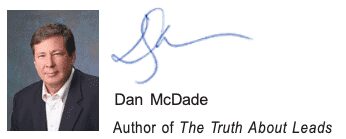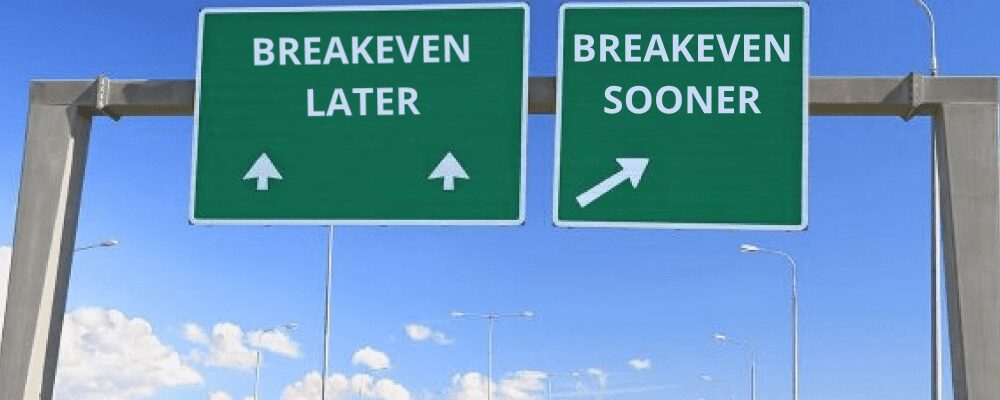What Should Your Close Rate Be?
By Dan McDade of Prospect Experience
A well-known industry analyst firm reports that best-in-class companies close 30% of sales qualified leads while average companies close 20%. This factors in that between 52% to 86% of the marketing qualified leads put into the top of the funnel leak out before they are considered sales qualified.
If you do the math, this tells us that sales reps are expected to work 1,000 marketing qualified leads down to 14 to 48 sales qualified leads and close 20% to 30% of those leads respectively; and end up with 3 to 14 deals. Not very efficient, right? (see the post about marketing segmentation)
The reality is that sales isn’t qualifying 1,000 marketing qualified leads to 3 to 14 sales qualified leads. They don’t have the time or interest (or the DNA). What does happen? A few leads are cherry-picked out—and other leads are left to go into the black hole called CRM.
Imagine Spending $208,350 on Marketing Leads That Are Trashed Immediately
One of the biggest software companies in the world has a division that spends over $200,000 per year on leads that sales refuses to follow-up on. Why don’t they follow-up? Because it turns out that only 1.8% of the so-called leads were even with qualified companies. None were actually leads. What chance do you think there is that sales will work thousands of “leads” when they know that fewer than 2% of them are even qualified companies? The sales close rate on these leads is zero percent. What a waste.
Sales Close Rate Example
It is amazing how low the close rate can be to break-even on converting marketing qualified leads to sales qualified leads via lead qualification and nurturing, and what the return is on good sales lead management.
Assumptions:
- Margin is 60% (probably conservative for software and services)
- Cost per sales qualified lead is $1,250
- Assume that the deal size is either an on-premise license sale or a SaaS solution with the net present value calculated—for this example we want to make the math easy.
- For a $300,000 deal ($180,000 in margin) the close rate would need to be .694% (not even 1%).
- For a $100,000 deal ($60,000 in margin) the close rate would need to be 2.08%.
- And for a $10,000 deal ($6,000 in margin) the close rate would need to be 20.8%.
If 50% of the leads provided were with not qualified companies (only the best companies achieve this), the necessary close rates would double to roughly 1.4%, 4.2% and 42% respectively. Lower quality leads cause the necessary close rates to go up even more —and at some point the average deal size does not support generating the leads in the first place.
If the average company could, in fact, close 20% of sales qualified leads the ROMI would be $28.80 for every $1 invested (again based on 60% gross margin).
I find that close rates are generally over-stated. When I ask sales executives what percent of sales qualified leads they can close their answer is generally in the 60% to 80% range. What they mean is that they will close 60% to 80% of what they thought they would close. Close rates probably can be a lot lower than most people think. Not that they should be. But they can be.
Finally, no sales executive wants to admit that they are closing 1-out-of-10 opportunities (as an example). So, they don’t provide visibility into the pipeline until late in the game which causes inaccurate forecasts and other pain.
Recap
- What is a healthy close rate for your solution(s) and/or service(s)?
- How much money could you save and how much more revenue could you generate if you understood the optimal close rate and provided sales with sales qualified leads?
Did you know that leads cost more than you think, but probably a lot less than you are currently paying? Contact us to discuss your close rates and how our high quality leads can improve your sales team performance.

Frequently Asked Questions
What is the Difference Between a Marketing Qualified Lead (MQL) and a Sales Qualified Lead (SQL)?
A Marketing Qualified Lead (MQL) is a lead that has shown interest in your product or service and meets certain criteria set by the marketing team, indicating potential for engagement. A Sales Qualified Lead (SQL), on the other hand, is an MQL that has been further evaluated and deemed ready for direct sales follow-up. SQLs show a higher intent to purchase and meet specific sales criteria, making them closer to a buying decision.
How Can I Improve My Sales Close Rate?
Improving your sales close rate involves several strategies, but should start with enhancing lead quality through better targeting and segmentation, improving sales team training and resources, implementing effective lead nurturing processes, and utilizing data analytics to refine your approach continuously. Additionally, aligning sales and marketing efforts to ensure a seamless transition of MQLs to SQLs can significantly impact your close rates.
What Are Common Mistakes That Affect Close Rates?
Common mistakes include focusing on quantity over quality of leads, poor lead nurturing processes, lack of alignment between sales and marketing teams, inadequate understanding of customer needs, and failing to adapt sales strategies based on customer feedback and changing market conditions. These issues can lead to low engagement and conversion rates.
How Do I Calculate the Return on Marketing Investment (ROMI) for Sales Leads?
To calculate ROMI, you first determine the total revenue generated from sales leads and subtract the total cost spent on generating those leads. Then, divide this net gain by the total cost of the leads. Multiply the result by 100 to get the ROMI percentage. This formula helps businesses understand the effectiveness of their marketing efforts in generating profitable sales leads.
What Strategies Can Be Implemented to Reduce Lead Leakage?
Strategies to reduce lead leakage include improving lead qualification criteria to ensure only high-quality leads are passed to sales, implementing a robust lead nurturing program to keep leads engaged throughout the sales funnel, and utilizing CRM and marketing automation tools to track and manage leads efficiently. Regular communication and feedback loops between sales and marketing teams can also help identify and address leakage points.
Why Do Sales Teams Often Overstate Close Rates?
Yes. Sales teams often overstate close rates due to optimism about their pipeline, a desire to meet or exceed targets, and sometimes, a lack of visibility into the entire sales process. This overestimation can lead to unrealistic forecasts and planning issues. Establishing clear criteria for what constitutes a sales qualified lead and maintaining transparency throughout the sales process can help in providing more accurate close rate estimates.




